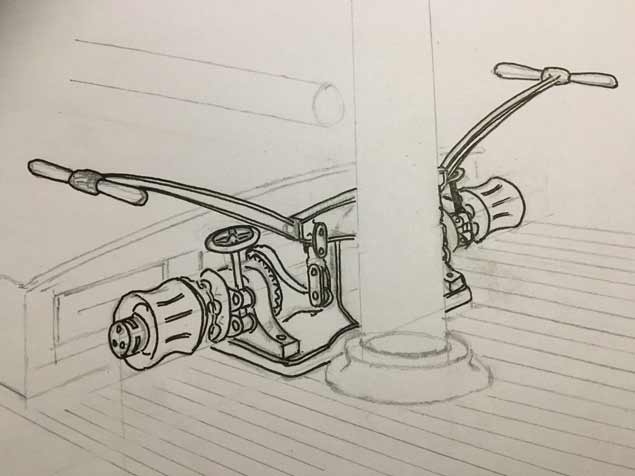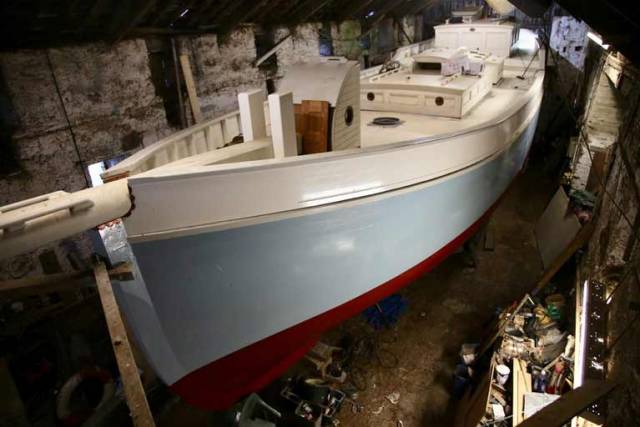The historic 1926-built 56ft ketch Ilen is to exit The Old Cornstore in Liam Hegarty’s boatyard at Oldcourt near Baltimore, the building which has accommodated her re-birth, early in the New Year writes W M Nixon.
Much remains to be done before she can be subsequently put afloat in April. But the pace of productivity in recent days, with the efficient completion of several jobs by the beefed-up team of nine craftsmen who have put in some very long days, shows what can be achieved as the work reaches it optimum pace.
The actual business of moving the ship out to an area of hard-standing, getting her there from a very limited space and negotiating some formidable obstructions en route, will be drawing on the deepest reserves of West Cork ingenuity, and deploying certain floating vehicles in unexpected ways.
All will be revealed in due course. But when we look at the photo of Ilen as she was when the programme was gathering pace, and compare it to photos of the ship as she is today, we realize - yet again - that the Ilen Project is something very special indeed, and dealing with unusual challenges is all part of the day’s work.
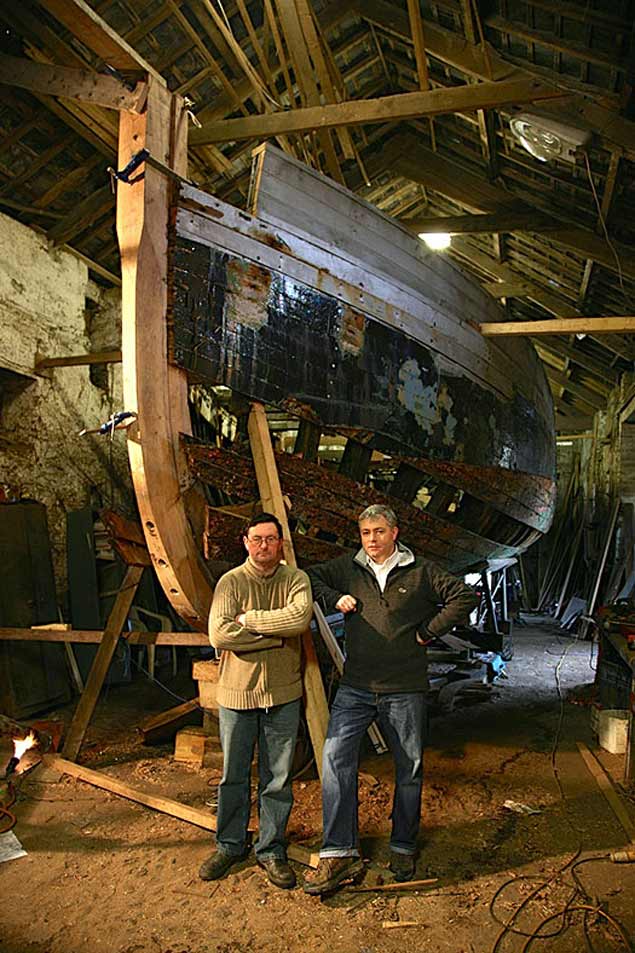 The Ilen Project has certainly moved on. Liam Hegarty (left) and Gary MacMahon at an early stage of the restoration
The Ilen Project has certainly moved on. Liam Hegarty (left) and Gary MacMahon at an early stage of the restoration
 It is now possible to visualise the Ilen thrusting her way purposefully through the seas. Photo: Gary MacMahon
It is now possible to visualise the Ilen thrusting her way purposefully through the seas. Photo: Gary MacMahon
 Inside the ship, with sole floors fitted, a real sense of the space which will become available is now apparent.
Inside the ship, with sole floors fitted, a real sense of the space which will become available is now apparent.
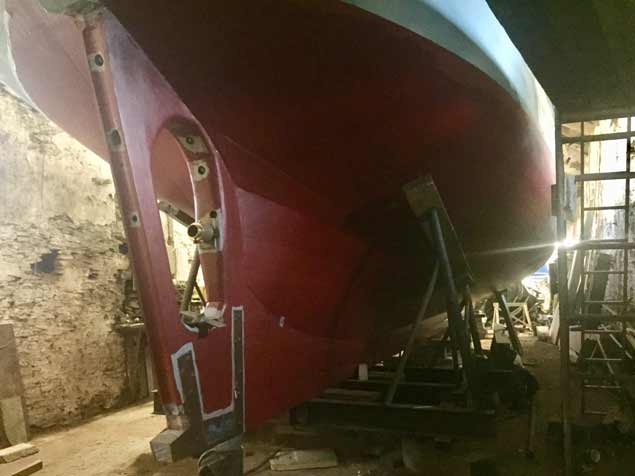 The business end. For her work as an inter-island trading. freight and passenger-carrying vessel, the mainly sail-powered Ilen needed the added reliability of powerful auxiliary motor, and space had to be provided for a substantial propellor. Photo: Gary MacMahon
The business end. For her work as an inter-island trading. freight and passenger-carrying vessel, the mainly sail-powered Ilen needed the added reliability of powerful auxiliary motor, and space had to be provided for a substantial propellor. Photo: Gary MacMahon
When Conor O’Brien of Foynes Island and Tom Moynihan of Baltimore were designing Ilen’s propellor installation, they took account of the fact that Ilen would be using some very confined little harbours and rudimentary piers, and the extra manoeuvrability conferred by having an intact rudder would give greatly-improved prop thrust. Many yachts of the day being fitted with auxiliaries used the easy option of taking much of the propellor aperture out of the rudder, thereby negating the effectiveness of the prop thrust for tight turns. But Ilen’s designers ensured that the entire aperture was taken out of the deadwood, leaving all the benefits of a completely intact rudder. Photo: Gary MacMahon
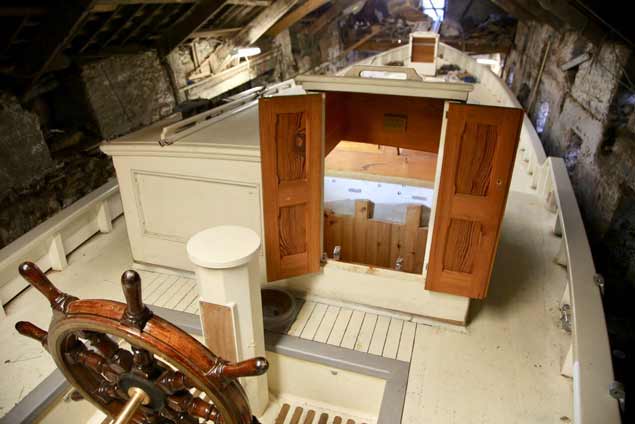 The helmsman’s view of “a small tall ship”. Photo: Gary MacMahon
The helmsman’s view of “a small tall ship”. Photo: Gary MacMahon
 Everything in and around Ilen’s aft footwell was made in the Ilen Boat-Building School in Limerick, except for the steering wheel. The original had long since been replaced by something very basic, but as Conor O’Brien had said that the optimum diameter for the wheel would be 42 inches, when a genuine wheel of 41 inches diameter was spotted in an antiques fair in the city, it was immediately secured for the Ilen Restoration. Photo: Gary MacMahon
Everything in and around Ilen’s aft footwell was made in the Ilen Boat-Building School in Limerick, except for the steering wheel. The original had long since been replaced by something very basic, but as Conor O’Brien had said that the optimum diameter for the wheel would be 42 inches, when a genuine wheel of 41 inches diameter was spotted in an antiques fair in the city, it was immediately secured for the Ilen Restoration. Photo: Gary MacMahon
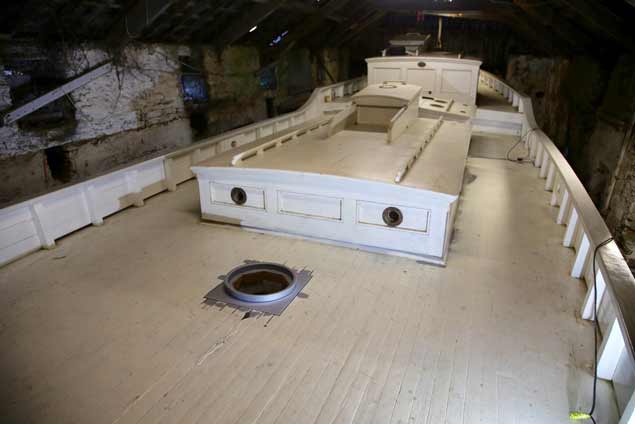 The deck design in the way of the mainmast has a definite clear space between the mast and the coachroof, a space intended for a manually-operated anchor windlass. An authentic replacement windlass has already been sketched out by David Webster (below)
The deck design in the way of the mainmast has a definite clear space between the mast and the coachroof, a space intended for a manually-operated anchor windlass. An authentic replacement windlass has already been sketched out by David Webster (below)
